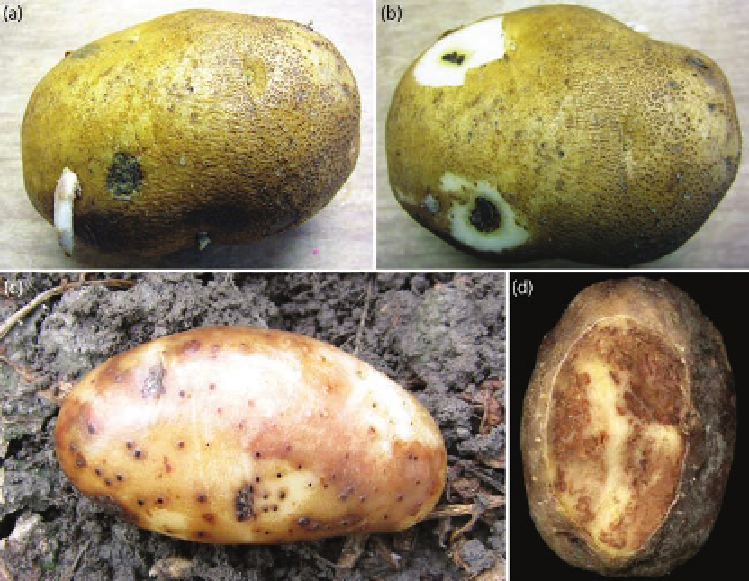Agriculture Reference
In-Depth Information
smaller tubers, yield loss, and lower tuber dry
matter content (Stevenson
et al
., 2007).
Tuber symptoms of early blight include cir-
cular to irregular lesions that are slightly sunken
and often surrounded by a raised purple to dark
brown border
(Fig. 11.8a
)
. The underlying tissues
are leathery to corky in texture, dry and usually
dark brown and surrounded by a yellow halo (
Fig.
ketability of fresh market tubers. Tuber infection
also presents a challenge to processors, as tuber
lesions often require additional peeling to remove
the darkened lesions and underlying tissues (Ste-
venson
et al
., 2007). Early blight tuber lesions
(Fig.
11.8a,b
) can be distinguished easily from late
blight tuber lesions
(Fig. 11.8c,d)
, which are char-
acterized by discoloration of the potato skin
(Fig.
rot underneath the discolored skin
(Fig. 11.8d
)
.
Overwintering spores and mycelia of
A. solani
and
A. alternata
are melanized (darkly pigmented)
and can withstand a wide range of environmental
conditions, including exposure to sunlight and
repeated cycles of drying, freezing, and thawing.
In spring, spores (conidia) serve as primary inoc-
ula to initiate disease (Kirk and Wharton, 2012).
Plants grown in fields or adjacent to fields where
potatoes have been infected with brown leaf spot
during the previous season are most prone to in-
fection, since large quantities of overwintering
inoculum are likely to be present from the previ-
ous crop. Initial inoculum is moved readily
within and between fields, as air currents, wind-
blown soil particles, splashing rain, and irriga-
tion water carry the spores easily.
Alternating wet and dry periods with tem-
peratures between
5
and 30°C (the optimum is
20°C) in this range favor
Alternaria
spore pro-
duction. Few spores are produced on plant tissue
that is continuously wet or dry (Stevenson
et al
.,
2007). Many cycles of early blight and brown
leaf spot spore production and lesion formation
occur within a single growing season once primary
infections are initiated
(Fig. 11.9
). Secondary
spread of these pathogens begins when spores
are produced on foliar lesions and carried to
Fig. 11.8.
Tuber symptoms of early blight, caused by
Alternaria solani
(a,b) and late blight (c,d)
.
Early
blight lesions on tubers (a) are usually circular to irregular and slightly sunken, often surrounded by a
raised, purple to dark brown border. (b) Underlying tissues are leathery to corky in texture and usually
surrounded by a yellow halo. Late blight tuber lesions are characterized by discoloration of the potato skin
(c) and a tan to reddish-brown, dry, granular rot underneath the discolored skin (d).

